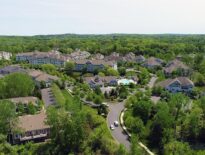Advocates for people experiencing homelessness and elected officials are hoping to capitalize on pandemic-era experiences in an effort to shift the state’s shelter system to other settings, like repurposed hotels or purpose-built shelters with individual rooms. The move, they say, would more effectively help people towards permanent housing opportunities.
During a Housing Committee hearing Tuesday, Rep. Natalie Higgins pushed House and Senate colleagues to advance legislation (H.3959) that seeks over a five-year period to end the use of congregate shelters by the Department of Housing and Community Development and create plans to streamline housing services.
“I come at it from a trauma background. I spent 10 years as a rape crisis counselor. For so many of my community members, going to a massive shelter is not a safe place, and they were choosing to stay on the streets,” the Leominster Democrat told the News Service after the hearing.
As COVID-19 cases surged and the pandemic tightened its grip on the state, congregate shelters looked to depopulation as a way to curb the spread of the virus among residents. Some municipalities and shelter providers set up non-congregate settings like repurposed vacant hotels that allowed people to reside in private accommodations.
Western Massachusetts Network to End Homelessness Director Pamela Schwartz said Higgins’ proposal is “a lessons learned bill.”
“We saw it with hotels over the pandemic, people are housed more quickly when they’re in hotels, when they are in safe, dignified places, when they have better access to case management resources, and better peace of mind to do the paperwork and the logistics that are required to get rehoused,” Schwartz said.
The bill requires DHCD to incrementally reduce – and eventually end – congregate, dormitory-style shelter use over the course of five years. Future shelter procurements for unaccompanied adults experiencing homelessness, according to the bill text, would be allocated to non-congregate shelter funding.
Joyce Tavon, senior director of policy and programs at the Massachusetts Housing and Shelter Alliance, said she understands the complexities associated with transforming the state’s shelter system to non-congregate over five years.
“There’s certainly reason to say like, ‘Is that a practical, realistic number?’ But it seems like we got to get bold, and we need to be doing that now so we just don’t fall back into doing things the same way,” she said.
The legislation directs DHCD to review and consider alternative shelter construction methods like modular construction, micro-units, or repurposed hotels. The department would also need to create an inventory of mass congregate shelters, their cost to the state, and conduct a feasibility study of the extent to which current resources can be converted to non-congregate shelters.
Higgins said she developed the bill based on challenges experienced in her district, which includes the city of Leominster. Higgins said the city does not have a permanent homeless shelter and when the pandemic hit, the city worked with DHCD to set up a temporary shelter.
“In the first two weeks, we were able to fill 26 beds. Now, despite those beds being expanded to 40, there is still a 30-person waitlist,” Higgins said. “This bill really seeks to make sure that there is shelter availability across the commonwealth, in everyone’s home community so that they can be stabilized and transitioned to housing that fits their needs.”
A spokesperson for DHCD, which describes its mission as overseeing “funding and resources to help people in Massachusetts live affordably and safely,” said the department does not comment on pending legislation and continues “to monitor the public hearing process in the Legislature.”
Tavon said transitioning to a non-congregate system is not the sole solution. Advocates and lawmakers need to pair that goal “with being much more proactive in our steps towards housing strategies,” Tavon said.
To that end, the legislation calls for a plan to “enhance and streamline” housing services for underserved populations like medically complex persons, the elderly, and disabled populations.
The plan would need to identify housing responses for unaccompanied single adults like long-term vouchers, shallow subsidy pools, rapid re-housing resources, and permanent supportive housing.
“It’s fair to say if 10 years from now we’ve replaced what right now is a patchwork quilt of emergency shelters dispersed across the state, and we’ve just replaced it with non-congregate shelters, but people have no option for moving on, we haven’t made great progress,” Tavon said. “I participate in some of the interviews with people living in these places and yes, it’s made a huge difference for them to have a place where they can close the doors, feel safe, and store their belongings and all the rest, but ultimately it’s about housing, and what’s the best pathway to get people into housing.”
The state does offer a series of housing and rental assistance programs that provide financial help to low-income people and those experiencing homelessness.
The Residential Assistance for Families in Transition Program (RAFT), for example, provides eligible households up to $10,000 to preserve current housing or move to new housing. The Massachusetts Rental Voucher Progam offers both tenant- and project-based rental subsidies.







